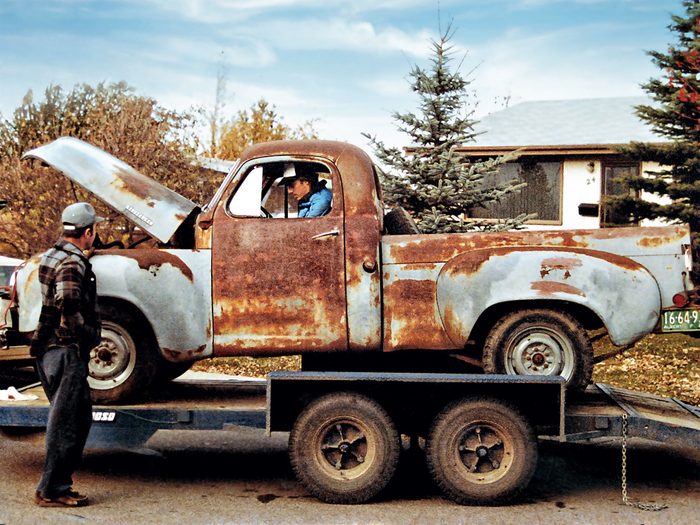
Restoring Our 1952 Studebaker Truck
In the fall of 1975, my husband Alfred brought home his father’s 1950 International half-ton truck from the family farm near Edson, Alberta. After seeing it sit on the driveway of our home for a few years, a co-worker of Alfred’s proposed to buy the vehicle; a deal was struck, and the truck changed hands over to a new owner.
Several years later, in 1983, our 17-year-old son was interested in getting his own vehicle. The idea of finding and reacquiring that old International half-ton came to mind. A phone call was made to Barry, the gentleman who had purchased the truck from Alfred, but unfortunately he had sold the old International and never saw the antique machine again. Barry called us a few months later, however, to tell us that he was in possession of a 1952 Studebaker truck—a 2R5 model half-ton—and it was up for sale; we were the first people he had thought to call and we didn’t hesitate to take him up on his offer.
So, in early October 1983, we headed off for Bonnyville, Alberta, where Barry lived at the time. With anticipation and optimism in our hearts and minds, we arrived and found what was neither beauty nor bliss, but merely an old derelict beast of a vehicle that had not been treated well over the years. This was our first look at the Studebaker, a small, hard-working farm truck from the postwar era, now the colour of rust versus its original gun-metal grey factory paint. The truck box had somehow managed to collect layers of dirt infused with weeds, grain and other assorted items, living and dead! My initial thought was, “We’re surely not going to bring this heap of junk home, are we?” However, Alfred and our son could see past the rust, bumps and bruises to a truck filled with character.
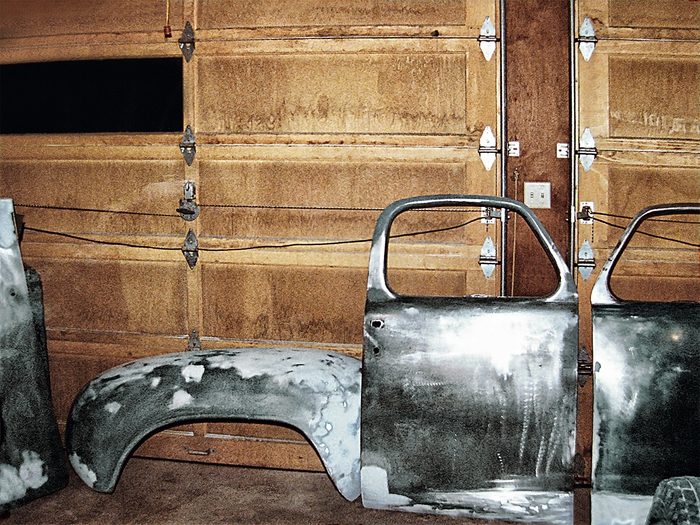
New Life For Our Old Studebaker Truck
To our amazement, Barry offered to start the Studebaker—surely this old hulk of metal wouldn’t start, let alone run! After Barry turned the key, the Studebaker fired to life without too much hesitation and we decided that it actually might be possible to bring this old truck back to road-worthy condition. A handshake deal was made and in late October we rented a car-hauler trailer to transport the Studebaker home to Sherwood Park. When we arrived, our neighbours helped us push the old truck off the trailer, up the driveway and right into the garage.
Bit by bit, piece by piece, everything that could come apart was taken apart—windows, doors, bumpers, fenders, seats, you name it. By the time we were done dismantling, only the wheels, chassis, cab and engine remained in place. Every little screw, bolt and nut that had been removed was put into containers and marked; the bigger pieces were set aside in order and by category. The process of restoring our 1952 Studebaker truck was truly underway and it became our family project for the winter of 1983-1984.
There was much grinding and sanding and filling to do to transform the bumps and bruises on the truck body into a smooth surface ready for painting. It was a very repetitious and tedious job—but immensely worth it in the end. Without the aid of the Internet, which had not been made available for use by the general public at that time, we sourced the required parts the old-fashioned way—phone calls made with a rotary phone to local businesses.
Find out the best-selling car from the year you were born.
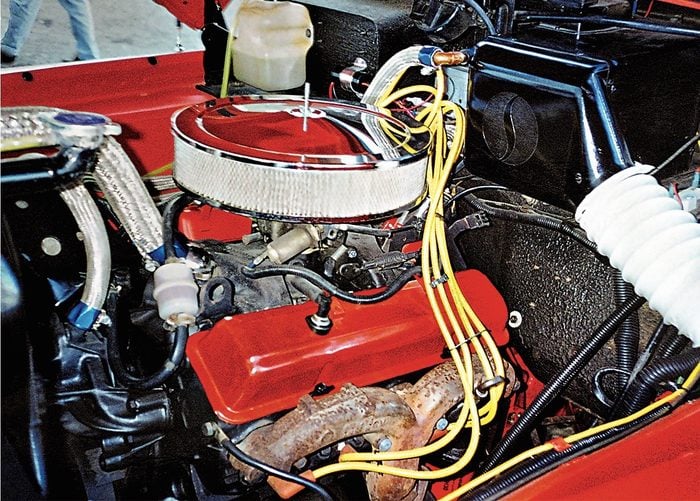
The Hunt For Studebaker Truck Parts
We also joined the Edmonton chapter of the Studebaker Club, where other members provided direction to help us locate authentic Studebaker truck parts for the 2R5 model. On weekends, we would tour parts suppliers, known back then as “junkyards.” Surprisingly, we actually managed to find most of our parts in farmyards throughout Alberta—these old machines hadn’t all been buried yet!
By December 1983, most of the disassembled parts were ready for primer and paint. In January 1984, Alfred worked on the brakes, once again sourcing parts from local businesses. Our son was taking welding in high school, so a cutting torch and MIG welder were rented, and he put his developing skills to good use reworking the metal body and taking care of any remaining parts that needed to be fabricated or fixed. The project was truly coming together now!
February arrived and we began the priming. Sheets of plastic were hung from the ceiling in the garage—our improvised autobody shop—and taped off to create an area free of dust while the priming was completed. Our son wanted to keep the truck as close as possible to its original showroom version. However, a few things just seemed to make sense to change, including the original colour of the truck and the wheels to make it a bit sportier looking. Not a hot rod in the technical sense, it would be classified as “mildly modified” at a current-day competitive show car.
Consider yourself a classic car expert? Take our vintage cars quiz.
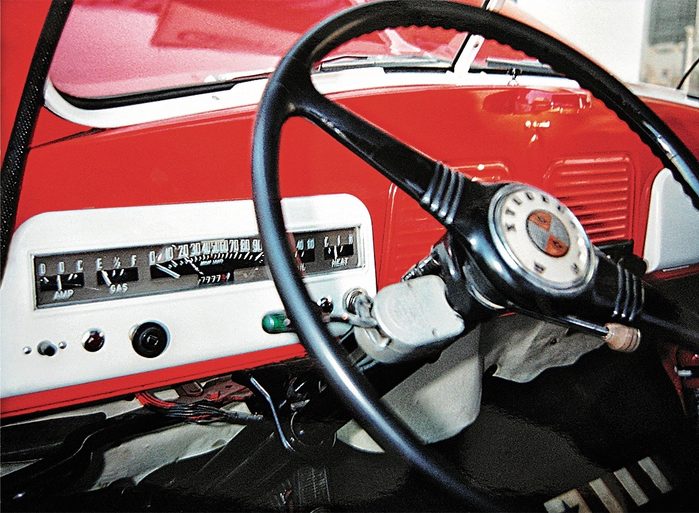
Seeing the Old Studebaker Truck Come to Life
After the primer layer was complete, the new paint was sprayed on. Alfred did the painting, with some coaching from a neighbour who was in the autobody business. It was wonderful watching the old girl come to life!
By mid-March, the bright-red body parts hung from the garage ceiling, waiting their turn to be installed on the chassis and frame. The lettering “Studebaker” had been embossed on the tailgate from the factory. To add some contrast, this was painted black. The rear window had been removed and taken to a local glass business, where “Studebaker” was etched into it to add more character and clearly show the brand of vehicle. All the new glass was installed and the cab interior was refitted with an eye-catching, black-diamond vinyl finish. The original model came without a radio, so a new cassette-radio was installed, along with speakers.
By the end of May 1984, the truck was whole once again. At one point, we pushed it out of the garage to get a clear view of what the colour looked like in daylight conditions. Our neighbours who had seen the truck roll into the garage back in the fall could not believe it was the same machine!
This impressive Model A Ford restoration took 40 years to complete!
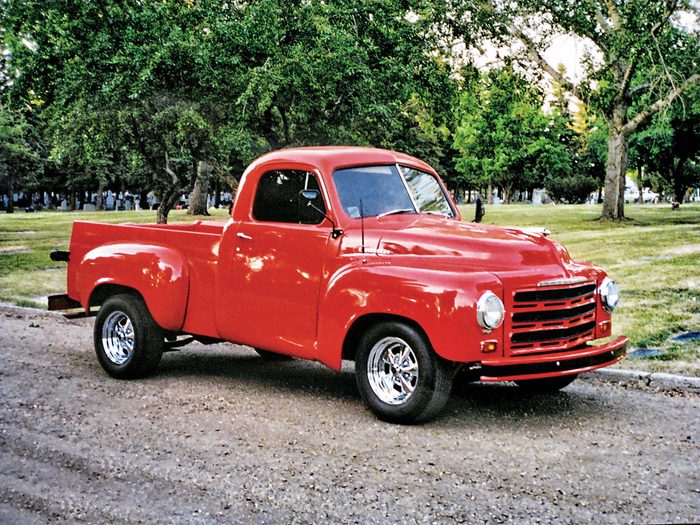
The Restored Studebaker Truck Finds a New Home
After seven months, the restoration project was about complete, with just a few minor things to sort out here and there. The “new” truck certainly looked transformed, and both father and son were proud of their accomplishments. The original motor was swapped out for a slightly newer and fresher 1974 Chevrolet 350cc engine and matching three-speed manual transmission. The standard “three on the tree” steering column shift was maintained.
Over the years, our ’52 Studebaker was entered into many auto shows around the Edmonton area. Since it didn’t qualify for the “original” or “modified” classes at that time, it was more of a winner in our hearts than on the judges’ score sheet. It maintained a place in our garage, where it was free of the inclement Alberta weather, and every now and again, our son would take it out to experience the pleasure of driving a vintage machine that helped sculpt the Alberta and Canadian agriculture landscape—a worthy vehicle having earned its own right of passage.
On June 22, 2002, the Studebaker was sold to a gentleman living in the Sherwood Park area. On occasion while roaming around town, we spotted the little red truck and thought of the time it had been in our garage, warm and protected. With some regret from our son, who had been proud of the Studebaker, the old girl had found her way into another family who could enjoy this new incarnation of a very dependable postwar farm truck.
Next, check out 10 vintage trucks that never went out of style.